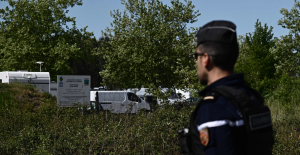The encirclement of the 6th Army and other Wehrmacht units in Stalingrad in November 1942 is generally regarded as a masterpiece by the Soviet strategist Georgy Zhukov, who was also appointed Marshal of the Soviet Union by Stalin. Together with the chief of staff, Alexander Wassilewski, he conceived and planned “Operation Uranus”.
"The entire course of the Russian counter-offensive was marked by the tactical skill with which General Zhukov chose his spearheads, both psychologically and topographically. He always hit the soft spots in the enemy's position. He also showed the rare ability to come up with a new threat whenever his attacking forces had lost the initial momentum..." said the great British military historian Basil Liddell Hart.
It is easy to overlook Zhukov's role in the Soviet offensive. While Vasilevsky coordinated the attack on the Volga and in the Caucasus, Zhukov was to advance north-west of Moscow. "Operation Mars" was the name of the undertaking that began on November 25, 1942 and reached its climax in December. Stalin biographer Simon Sebag Montefiore is among the few historians who have kept track of the result: "In less than two days of an offensive, he (Zhukov, ed.) sacrificed hundreds of thousands of men." It was probably the most bitter defeat , which Zhukov, who was to conquer Berlin in 1945, had to accept.
Stavka, Stalin's headquarters, had prepared more than 800,000 soldiers and around 2,300 tanks for the attack. Together with the participating troops of the Kalinin and Western Fronts, almost two million men, 3300 tanks, more than 23,000 guns and more than 1000 aircraft were ready to carry out the order: "The formations of the right wing of the Western Front and the left wing of the Kalinin Front have to encircle the enemy forces in the Rzhev bridgehead, capture Rzhev and regain control of the Moscow-Veliki railway line.”
The objective was a 150 square kilometer salient in the German front stretching between Smolensk and Kalinin and held by General Walter Model's 9th Army. Unlike in the south, where German reconnaissance had fatally failed to find any Red Army reserves, the Foreign Army East Division expected a large-scale attack in the area of Army Group Center.
Additional troops and artillery were deployed and field fortifications put up in good time. The ten Soviet armies that carried out the attack succeeded in the first few days in distressing the German defenses. But already at the beginning of December it was possible to stabilize the front again.
Even more. A counterattack on December 7, despite the lack of air support due to the weather, led to the Soviet 41st Army being surrounded within a short time, which was wiped out within a few days. By mid-December the situation had largely stabilized, and Soviet losses totaled more than 330,000 men, including 100,000 dead. The opposing side lost 40,000 men dead and wounded.
The military historian Bernd Wegner, who analyzed "Operation Mars" for the series "The German Reich and the Second World War" of the Bundeswehr Center for Military History and Social Sciences, comes to the conclusion that the successful defense is primarily due to the "comparatively unproblematic Cooperation” between the local leadership and Hitler and his staff can be explained. Quite unlike on the Stalingrad front, the dictator gave his consent to local straightening of the front, while retreats were euphemistically concealed. With the reserves thus gained, the counterattacks could be set in motion.
The American military historian David Glantz has pointed out another aspect. Unlike before Stalingrad, the flanks of the attacked 9th Army were not held by Allied troops. The statement is undoubtedly correct, but overlooks the dramatic supply situation and overstretching of the fronts on the Volga and Caucasus. Experts doubt whether German troops could have withstood the onslaught of the Red Army in the steppes with the same inadequate equipment that the Romanian armies had at their disposal.
"In the unlikely event that Zhukov is right and 'Mars' was really just a distraction, then there has never been one so big and clumsily executed, nor one so costly," sums up Glantz. But that's only part of the story. A situation resembling that of Stalingrad arose at Velikie Luki, an important railroad station in the extreme north-west of the combat area. Around 7000 German soldiers were surrounded by superior Soviet forces.
Instead of allowing a withdrawal from the front here as well, Hitler demanded the restoration of the “status quo ante” as an ultimatum. The defenders had to hold out until January 1943, and several attempts by weak troops to relieve them failed. Eventually the surviving remains were so exhausted that an escape was impossible. They've been crushed.
"Similar to what happened at the same time 1200 kilometers in Stalingrad, no responsible front-line commander was willing in the present case ... to take the fate of units under his command into his own hands without considering the orders given." There is nothing to add to Bernd Wegner's judgment .
You can also find "World History" on Facebook. We are happy about a like.
This article was first published in December 2012.

 His body naturally produces alcohol, he is acquitted after a drunk driving conviction
His body naturally produces alcohol, he is acquitted after a drunk driving conviction Who is David Pecker, the first key witness in Donald Trump's trial?
Who is David Pecker, the first key witness in Donald Trump's trial? What does the law on the expulsion of migrants to Rwanda adopted by the British Parliament contain?
What does the law on the expulsion of migrants to Rwanda adopted by the British Parliament contain? The shadow of Chinese espionage hangs over Westminster
The shadow of Chinese espionage hangs over Westminster Colorectal cancer: what to watch out for in those under 50
Colorectal cancer: what to watch out for in those under 50 H5N1 virus: traces detected in pasteurized milk in the United States
H5N1 virus: traces detected in pasteurized milk in the United States What High Blood Pressure Does to Your Body (And Why It Should Be Treated)
What High Blood Pressure Does to Your Body (And Why It Should Be Treated) Vaccination in France has progressed in 2023, rejoices Public Health France
Vaccination in France has progressed in 2023, rejoices Public Health France The right deplores a “dismal agreement” on the end of careers at the SNCF
The right deplores a “dismal agreement” on the end of careers at the SNCF The United States pushes TikTok towards the exit
The United States pushes TikTok towards the exit Air traffic controllers strike: 75% of flights canceled at Orly on Thursday, 65% at Roissy and Marseille
Air traffic controllers strike: 75% of flights canceled at Orly on Thursday, 65% at Roissy and Marseille This is what your pay slip could look like tomorrow according to Bruno Le Maire
This is what your pay slip could look like tomorrow according to Bruno Le Maire Sky Dome 2123, Challengers, Back to Black... Films to watch or avoid this week
Sky Dome 2123, Challengers, Back to Black... Films to watch or avoid this week The standoff between the organizers of Vieilles Charrues and the elected officials of Carhaix threatens the festival
The standoff between the organizers of Vieilles Charrues and the elected officials of Carhaix threatens the festival Strasbourg inaugurates a year of celebrations and debates as World Book Capital
Strasbourg inaugurates a year of celebrations and debates as World Book Capital Kendji Girac is “out of the woods” after his gunshot wound to the chest
Kendji Girac is “out of the woods” after his gunshot wound to the chest Skoda Kodiaq 2024: a 'beast' plug-in hybrid SUV
Skoda Kodiaq 2024: a 'beast' plug-in hybrid SUV Tesla launches a new Model Y with 600 km of autonomy at a "more accessible price"
Tesla launches a new Model Y with 600 km of autonomy at a "more accessible price" The 10 best-selling cars in March 2024 in Spain: sales fall due to Easter
The 10 best-selling cars in March 2024 in Spain: sales fall due to Easter A private jet company buys more than 100 flying cars
A private jet company buys more than 100 flying cars This is how housing prices have changed in Spain in the last decade
This is how housing prices have changed in Spain in the last decade The home mortgage firm drops 10% in January and interest soars to 3.46%
The home mortgage firm drops 10% in January and interest soars to 3.46% The jewel of the Rocío de Nagüeles urbanization: a dream villa in Marbella
The jewel of the Rocío de Nagüeles urbanization: a dream villa in Marbella Rental prices grow by 7.3% in February: where does it go up and where does it go down?
Rental prices grow by 7.3% in February: where does it go up and where does it go down? Europeans: “All those who claim that we don’t need Europe are liars”, criticizes Bayrou
Europeans: “All those who claim that we don’t need Europe are liars”, criticizes Bayrou With the promise of a “real burst of authority”, Gabriel Attal provokes the ire of the opposition
With the promise of a “real burst of authority”, Gabriel Attal provokes the ire of the opposition Europeans: the schedule of debates to follow between now and June 9
Europeans: the schedule of debates to follow between now and June 9 Europeans: “In France, there is a left and there is a right,” assures Bellamy
Europeans: “In France, there is a left and there is a right,” assures Bellamy These French cities that will boycott the World Cup in Qatar
These French cities that will boycott the World Cup in Qatar NBA: the Wolves escape against the Suns, Indiana unfolds and the Clippers defeated
NBA: the Wolves escape against the Suns, Indiana unfolds and the Clippers defeated Real Madrid: what position will Mbappé play? The answer is known
Real Madrid: what position will Mbappé play? The answer is known Cycling: Quintana will appear at the Giro
Cycling: Quintana will appear at the Giro Premier League: “The team has given up”, notes Mauricio Pochettino after Arsenal’s card
Premier League: “The team has given up”, notes Mauricio Pochettino after Arsenal’s card


















